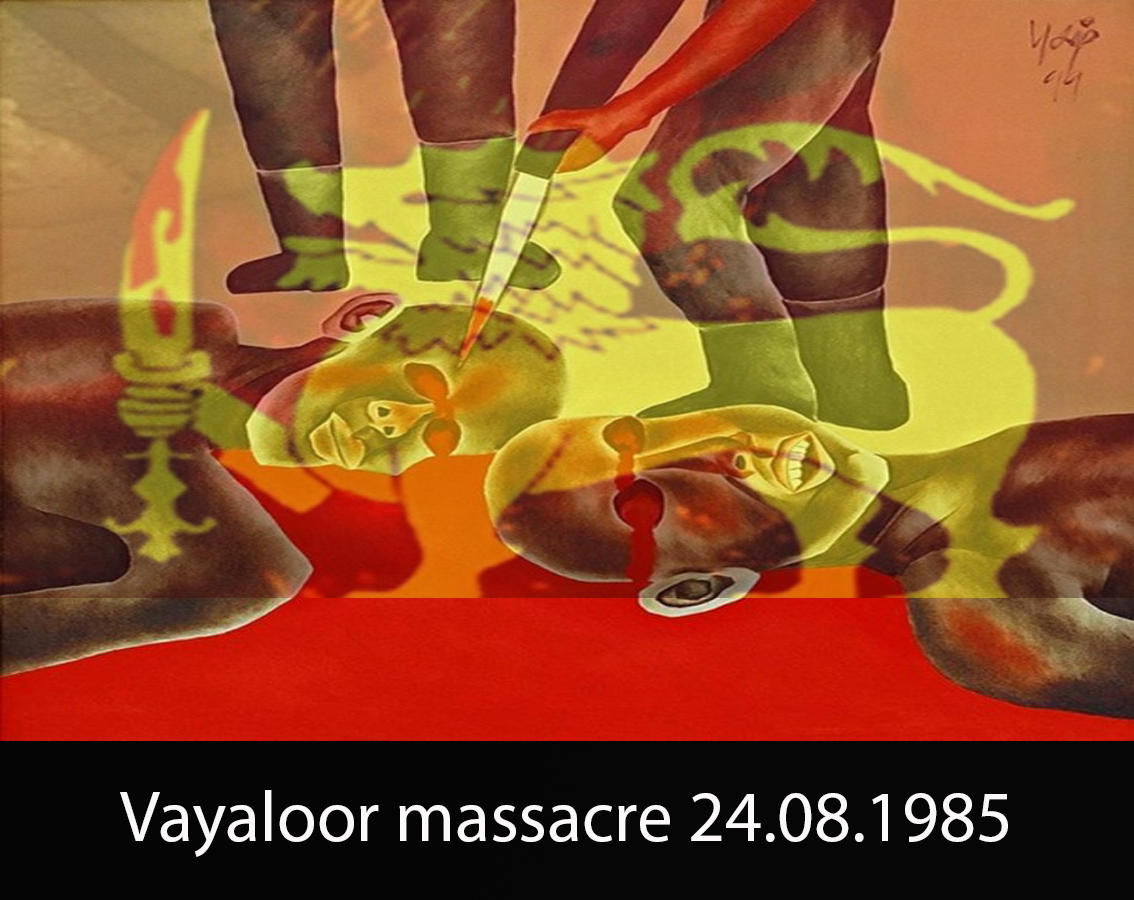

Vayaloor massacre 24.08.1985

Vayaloor is situated in the Amparai district. Valayoor, Sagamam was a colony of the landless poor who were settled in 1972 under the government’s plan to give “the highest priority to the development of land for the production of food and other crops”. To reach Vayaloor, one has to travel eight miles on foot as there is only a jungle path leading
to the village. There were 200 families living in the village and they had no access to clean drinking water, no shops and the nearest government dispensary was 10 miles away. Yet they continued to stay and cultivate crops like maize, kurakkan, manioc, yams and other vegetables, depending on rainwater. Traders from distant places went there in bullock carts to collect agricultural produce from the chenas. The people built their homes with poles and mud, thatched them with either coconut cadjan, or grass.
After the attack, which occurred during a ceasefire period, the settlement was deserted and now the land has been taken over by the jungle. When people left Valayoor, they did not carry any of their belongings. They fled with what they were wearing. They had lost all their possessions including animals, crops and savings.
The attack on the people at Vayaloor started in the early hours on the 24th August 1985. S.Vijeya widowed by the Vayaloor attack, is a mother of five. She says,
“It was about 6 o’clock in the early house of the day: I was at the hearth trying to light the fire to prepare the tea. All of a sudden I noticed that there were a number of men in army fatigues carrying guns standing around our hut. I was terrified – much afraid of the visitors. I began to tremble.
The soldiers found that I had seen them and observing my nervousness, approached me with a volley of questions, (in Sinhala), which I did not understand. Just then my husband walked in and the soldiers spoke to him and through friendly gestures and show of hands asked him to join them with the bucket we use for drawing water from the well. My husband was asked to follow them and I joined them too. The soldiers rounded all the males above 18 years from the huts but allowed the aged, the sick and the weak to remain. They took all the able bodied youths with them. Even woman were taken along. We walked through the jungle path towards the East.
The soldiers wanted the men to fetch some water for them to wash before breakfast. It was around 8 o’clock. The men obliged and the soldiers ate their food and we starved – did not even have a cup of plain tea.
When their breakfast was over, they asked the people to accompany them on their journey but never told us as to where they were taking us to. We complied with their orders and proceeded along the jungle path when we met another group of soldiers, and the officer commanding that group found fault with the soldiers who had taken women together with men. The second group leader came up to the women and spoke in Tamil and said, “Do not proceed further with the men. The soldiers are in an unfamiliar area. We need men. Wait there under the tree until noon and get back to your places and your men will return to you after showing us the way.” We remained at that place waiting for our men who went in the direction of Kumarankulam, but they did not return.
The sun came vertically over our heads and there were no signs of the men returning. Since we had to prepare food for our children and for the men who had gone with the soldiers, we returned to our huts and busied ourselves cooking food that we did not eat.
As we were waiting for the men to return, a message came of killing. The messenger, who himself had escaped death, said the remains of those killed were scattered in the Kumarankulam area. I could not believe the message but when the other women started going to the homes of relatives at Kolavil, Panankadu and Akkaraipattu in search of safety, I too left Vayaloor. I left everything behind as they were and went to my people.
The elderly persons whom the army left in their chenas proceeded to the place where the men were slaughtered. Grief-stricken relatives went to Kumarankulam in tractor-driven trailers and brought the dead to our ancestral villages who were buried according to customary rituals. We lost all that we owned at Vayaloor.”
A trader who went to Vayaloor frequently on business, Vyramuthu Kanagasabai, said,
“I went to Vayaloor – Periyatalawe on the 23rd evening with the hired double bullock cart to bring goods for the Sunday fair at TirukkoviI. I spent the night and helped to uproot the mature manioc. As I was preparing to leave the area on the 24th, I found the entire settlement rounded up. I remained in a hut with the farmers. I was taken into custody, but released. I don’t know what happened to the cart, the bulls and the carter I took to Vayaloor. I lost all the money I carried and the bicycle I used for my journey. When the soldiers asked me to run away, I went, but remained hiding a little away from Kumarankulam.
A little after I left the farmers, I heard the gunshots. When the soldiers left in their vehicles, I went to the place and saw the men shot dead. However, there were two who were injured. One was shot through the mouth. He did not die and the other was named Nadarasa. I returned to Vayaloor and conveyed the fate of the men. Kanagasabai confirmed that as many as 40 were killed.”